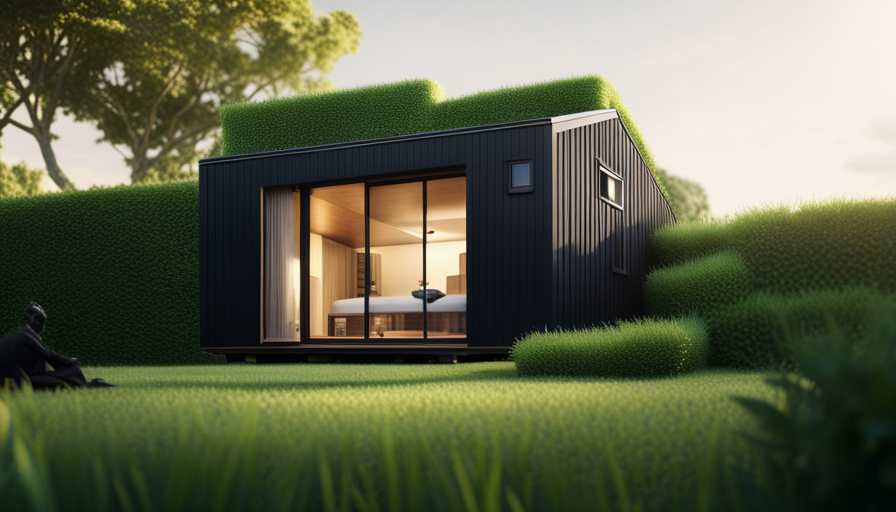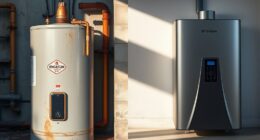Did you know that the average American household consumes around 10,399 kilowatt-hours (kWh) of electricity every year? That’s a staggering amount! But what if I told you that it’s achievable to power a small home with just a few car batteries? Yes, it’s true.
In this article, I will guide you through the process of determining exactly how many car batteries you would need to power your tiny house. First, we’ll assess your energy needs by considering factors such as lighting, appliances, and heating or cooling systems. Then, we’ll determine your power consumption based on the wattage ratings of these devices. With this information in hand, we can calculate the battery capacity requirements to ensure uninterrupted power supply.
But it doesn’t stop there. We’ll also discuss different battery types and sizes available in the market and explore various charging methods. Plus, I’ll share some backup power options for those unexpected outages.
Ready to embark on this electrifying journey? Let’s get started!
Key Takeaways
- Assess energy needs: Determine the power consumption of lighting, appliances, and heating/cooling systems in order to accurately calculate the number of car batteries needed for a tiny house.
- Calculate battery capacity requirements: Based on the wattage ratings of electrical devices, estimate the daily power consumption and use this information to determine the necessary battery capacity for uninterrupted power supply.
- Consider different battery types and sizes: Explore options such as lithium-ion and lead-acid batteries to find the most suitable choice for the tiny house’s energy requirements.
- Explore charging methods and backup power options: Evaluate various charging methods like solar panels and generators, and consider backup power options such as multiple sets of car batteries to ensure a reliable power supply.
Assess Your Energy Needs
Now let’s figure out how many car batteries you’ll need to power your tiny house. To determine this, we first need to assess your energy needs.
One of the most effective ways to reduce your power consumption is by using energy-efficient appliances. These appliances are designed to minimize electricity usage without compromising functionality.
Additionally, considering solar panel installation can greatly contribute to reducing your reliance on car batteries. Solar panels harness the sun’s energy and convert it into electricity, providing a sustainable and renewable source of power for your tiny house.
To accurately calculate the number of car batteries required, you must determine your power consumption. Start by identifying all the electrical devices you plan on using in your tiny house, including lights, electronics, heating or cooling systems, and any other appliances. Then, find their wattage ratings and estimate the average hours they will be used daily.
By multiplying the wattage rating with the estimated daily usage hours for each device and summing up these values, you will get an estimation of your total daily power consumption. This calculation will help determine how many car batteries you’ll need for sustained power supply without interruption.
With a thorough assessment of your energy needs and considerations towards energy-efficient appliances and solar panel installation, you can now move onto determining your power consumption requirements for powering a tiny house efficiently.
Determine Your Power Consumption
To accurately gauge your electricity needs for a compact living space, consider tracking the energy consumption of each individual appliance and lighting fixture. This will allow you to determine how much power you’re using and identify any energy guzzlers that may need to be replaced with more energy-efficient appliances.
Energy-efficient appliances are designed to minimize power consumption while still providing the same level of functionality. By replacing outdated or inefficient appliances with newer models, you can significantly reduce your overall power consumption.
Another alternative source of power for a tiny house is solar power. Solar panels can be installed on the roof of your tiny house to harness sunlight and convert it into usable electricity. This environmentally friendly option not only reduces your reliance on traditional power sources but also saves you money in the long run.
To ensure that your solar-powered tiny house has enough backup power during periods of low sunlight or high energy demands, it’s important to calculate the battery capacity requirements. This will help determine how many car batteries are needed to store enough electricity for your needs.
Calculate Battery Capacity Requirements
Harnessing solar power for your compact living space requires careful calculation of the battery capacity needed to ensure sufficient backup electricity during periods of low sunlight or high energy demands. To calculate battery capacity requirements, you need to start by determining your average daily energy usage.
This can be done by calculating the power consumption of each electrical appliance and device in your tiny house. Once you have a comprehensive list of all the electrical devices and their respective power ratings, you can estimate the number of hours each device will be used per day. Multiply the power rating by the number of hours used to determine the energy consumed by each device daily.
Sum up all these values to obtain your total daily energy consumption. To optimize power consumption, consider implementing energy-efficient practices such as using LED lights, choosing appliances with high Energy Star ratings, and minimizing standby power usage. By reducing unnecessary energy waste, you can decrease your overall battery capacity requirements and make better use of your available solar energy.
Calculating energy usage and optimizing power consumption are crucial steps in determining the battery capacity needed for a tiny house powered by solar panels. By accurately assessing your daily energy needs and implementing efficient practices, you can ensure that your system is appropriately sized to meet demand without wastage. Considering these factors will help pave the way for selecting suitable battery types and sizes that will be discussed in the next section about ‘considering battery types and sizes.’
Consider Battery Types and Sizes
When it comes to selecting the right battery for your solar-powered compact living space, it’s important to consider the types and sizes available. Different battery technologies offer varying benefits, so understanding their characteristics is crucial. Lithium-ion batteries are popular due to their high energy density and longer lifespan compared to lead-acid batteries. They also have a faster charging rate and are more lightweight, making them suitable for tiny house applications.
To help you visualize the different battery types and sizes, here’s a comparison table:
| Battery Type | Energy Density (Wh/kg) | Lifespan (cycles) |
|---|---|---|
| Lithium-ion | 150-200 | 1000-3000 |
| Lead-acid | 30-50 | 200-500 |
| Nickel-Iron | 40-60 | 2000+ |
As seen in the table, lithium-ion batteries provide higher energy density and longer lifespans compared to lead-acid or nickel-iron batteries. This means that they can store more energy per unit weight and endure more charge-discharge cycles.
Considering battery lifespan is essential because it determines how long your investment will last before needing replacement. With lithium-ion batteries lasting up to three times longer than lead-acid batteries, they offer better value in terms of longevity.
Assessing charging methods is the next step in ensuring an efficient power supply for your tiny house without compromising on performance or reliability.
Assess Charging Methods
Now let’s explore the different ways you can charge your solar-powered compact living space to ensure a reliable and enjoyable power supply. When it comes to charging methods for your tiny house, solar panels are an excellent option. They harness the sun’s energy and convert it into electricity, providing a sustainable and renewable power source. Solar panels are available in various sizes and capacities, allowing you to choose the most suitable option based on your energy needs.
In addition to solar panels, generator options can also be considered for charging your tiny house batteries. Generators provide a backup power source when sunlight is limited or during cloudy days. They come in different types such as gasoline, propane, or diesel-powered generators. Each type has its own advantages and considerations regarding fuel availability, noise levels, and emissions.
To determine the number of batteries needed for your tiny house, you should take into account both the energy requirements of your appliances and the charging capacity of your chosen method. By assessing these factors carefully, you can ensure that you have enough battery storage capacity to meet your power needs without any interruptions.
Transition: With an understanding of charging methods established, we can now move on to determining the number of batteries needed for powering a tiny house efficiently.
Determine the Number of Batteries Needed
To ensure an efficient and uninterrupted power supply, it’s crucial for you to accurately determine the number of batteries required for your compact living space. Here are four key factors to consider when determining the number of car batteries needed:
-
Power consumption: Calculate your daily power consumption by adding up the wattage of all your appliances and devices. Consider energy-efficient options and try to minimize unnecessary power usage.
-
Battery capacity: Determine the capacity of each car battery in ampere-hours (Ah). This information is usually provided by the manufacturer. Divide your total daily power consumption (in watt-hours) by the voltage of a single battery (usually 12 volts) to find out how many Ah you need.
-
Battery efficiency: Take into account that car batteries aren’t 100% efficient at discharging their stored energy. Typically, only about 50-70% can be used before recharging is necessary. Adjust your calculations accordingly.
-
Renewable energy sources: Incorporate renewable energy sources like solar panels or wind turbines into your system design. These can help recharge your batteries during daylight hours or when there is ample wind, reducing reliance on grid electricity.
By considering these factors, you can accurately determine the number of car batteries needed for powering your tiny house efficiently. Once you have determined this, it’s important to also consider backup power options in case of emergencies or extended periods without sufficient renewable energy generation.
Now let’s explore some backup power options that can ensure a reliable supply even under challenging circumstances such as inclement weather or equipment failure.
Consider Backup Power Options
Incorporating backup power options ensures a reliable supply of electricity, even in challenging circumstances. When it comes to powering a tiny house with car batteries, having backup power sources is essential for uninterrupted energy supply. While car batteries can provide the primary source of power, they may not always be sufficient or reliable. Therefore, considering additional backup options is crucial.
One option to consider is installing solar panels alongside the car batteries. Solar panels harness the sun’s energy and convert it into electricity, providing a sustainable and renewable source of power. By combining solar panels with car batteries, you can ensure a continuous supply of electricity during daylight hours and recharge the batteries for nighttime use.
Additionally, having multiple sets of car batteries as backups can further enhance reliability. This way, if one set fails or needs maintenance, you can switch to another set without any interruption in power supply. It’s important to regularly monitor and maintain both the car batteries and solar panel installation to maximize their efficiency and longevity.
By incorporating backup power sources like solar panels alongside car batteries, you can guarantee a steady flow of electricity for your tiny house. However, it’s also crucial to plan for maintenance and replacement of these systems to ensure long-term functionality without any disruptions or downtime.
Plan for Maintenance and Replacement
Ensure that you regularly maintain and replace your backup power systems to guarantee a reliable and uninterrupted flow of electricity for your cozy sanctuary. To effectively plan for maintenance and replacement of car batteries in your tiny house, it is essential to establish a comprehensive maintenance schedule.
This schedule should include regular inspections, cleaning, and testing of the batteries to identify any potential issues before they become critical. To maximize battery lifespan, it’s crucial to follow manufacturer guidelines regarding charging and discharging cycles. Overcharging or deep discharging can significantly reduce the lifespan of the batteries. Implementing a proper battery management system can help regulate the charging process and prevent these detrimental situations.
Here are four key factors to consider when planning for maintenance and replacement:
- Regularly check battery voltage levels using a multimeter.nn2. Clean battery terminals with a mixture of baking soda and water.nn3. Inspect cables for any signs of wear or corrosion.nn4. Test backup power systems periodically by disconnecting from the main power source.
By adhering to a well-defined maintenance schedule and following best practices for battery care, you can extend their lifespan while ensuring optimal performance for your tiny house electrical needs.
Transition into the subsequent section: Now that we’ve discussed how to properly maintain your backup power systems, let’s move on to budgeting for battery costs to make informed decisions about powering your tiny house efficiently.
Budget for Battery Costs
Don’t let the future shock you – preparing your finances for the electrifying cost of battery replacements is key to keeping your tiny oasis powered and thriving. When it comes to budgeting for battery costs, it’s important to consider both the lifespan of the batteries and their comparative costs.
To help you make an informed decision, I have created a table below that compares different types of car batteries commonly used in tiny houses:
| Battery Type | Lifespan (years) | Cost ($) |
|---|---|---|
| Lead-acid | 1-3 | $100-$200 |
| Lithium-ion | 5-10 | $500-$1000 |
As you can see, lithium-ion batteries have a significantly longer lifespan compared to lead-acid batteries. While they may come with a higher upfront cost, they offer better value in the long run due to their extended durability.
When planning your budget, it’s essential to factor in the number of batteries required for your tiny house and their respective costs. Additionally, keep in mind any additional expenses such as installation fees or maintenance charges.
Considering these factors will ensure that you allocate sufficient funds for battery replacements throughout the lifespan of your tiny house. Seek professional advice to determine the optimal number and type of car batteries needed based on your specific energy requirements.
Seek Professional Advice
To make sure you’re making the best decision for your energy needs, it’s worth seeking professional advice from experts who can guide you in choosing the right battery solution.
When it comes to powering a tiny house with car batteries, there are several factors that need to be considered, such as the size of the house, power consumption, and desired autonomy.
Consulting experts in this field will provide you with valuable insights into the specific requirements of your tiny house. They can assess your energy needs and recommend an appropriate number of car batteries based on their expertise and knowledge. These professionals have extensive experience working with different battery systems and can provide you with accurate information regarding their capabilities and limitations.
Getting professional guidance is crucial because they can help determine how many car batteries you will need to power your tiny house effectively. They will consider factors such as daily energy consumption, available charging methods, battery capacity, and expected lifespan. By analyzing these variables, they can assist in selecting the optimal battery solution that meets both your current needs and future expansion plans.
Seeking professional advice when considering using car batteries to power a tiny house is essential. Experts in this field have the necessary knowledge and experience to guide you through the process of choosing the right battery solution. Their technical expertise will ensure that your energy needs are met efficiently while also considering long-term sustainability. So don’t hesitate to consult professionals who can provide reliable guidance tailored specifically to your unique situation.
Frequently Asked Questions
How do I assess my energy needs for a tiny house?
To assess my energy needs for a tiny house, I start by assessing my energy usage. This involves determining the power requirements for all appliances and systems in the house. By analyzing the energy consumption of each device and estimating the daily usage, I can calculate the total energy needed.
Additionally, considering factors such as insulation, location, and climate will help me determine if alternative energy sources like solar panels or wind turbines are necessary to supplement or replace traditional power sources.
What factors should I consider when determining my power consumption?
When determining my power consumption, I need to consider several factors.
First, I should assess the energy efficiency of my appliances and devices. This involves checking their energy ratings and usage patterns.
Additionally, I should explore renewable energy sources like solar panels or wind turbines to offset my electricity needs.
By analyzing these factors, I can accurately assess my power consumption and make informed decisions about how many car batteries or other storage solutions are necessary for powering my tiny house efficiently.
How do I calculate the required battery capacity for my tiny house?
Calculating battery capacity for a tiny house involves considering various factors.
First, determine your daily energy consumption by adding up the power requirements of all appliances and devices.
Next, choose suitable batteries based on their capacity and voltage. Consider factors such as deep cycle batteries or lithium-ion batteries for better performance and longer lifespan.
Finally, divide the total energy consumption by the battery’s capacity to determine how many batteries you’ll need to power your tiny house efficiently.
What are the different types and sizes of batteries available for powering a tiny house?
When it comes to powering a tiny house, there are various types and sizes of batteries available. These include lead-acid, lithium-ion, and nickel-based batteries.
Lead-acid batteries are affordable but have shorter lifespans and require maintenance.
Lithium-ion batteries are more expensive but offer longer lifespans, higher energy density, and faster charging times.
Nickel-based batteries like NiMH and NiCd are less common due to their lower energy density.
The choice of battery depends on factors such as budget, energy requirements, and desired lifespan.
How can I assess the charging methods for my tiny house battery system?
To assess the charging methods for my tiny house battery system, I start by evaluating various options and comparing their efficiency. By analyzing data and conducting tests, I determine which charging method is most suitable.
This technical approach ensures an optimal solution for powering the battery system. It involves considering factors like solar panels, wind turbines, generators, and grid connections. Efficiency and reliability are key when selecting the right charging method for your tiny house battery system.
Conclusion
In conclusion, determining the number of car batteries needed to power a tiny house requires careful assessment and calculation. While some may argue that relying on car batteries isn’t cost-effective, it’s important to consider the energy needs and consumption patterns of the household.
By accurately calculating battery capacity requirements and exploring different types and sizes of batteries, one can find a solution that meets their power demands efficiently. Seeking professional advice will ensure a well-informed decision-making process.
With proper planning, maintenance, and budgeting, car batteries can be a viable option for powering a tiny house.
Hi, I’m Emma. I’m the Editor in Chief of Tiny House 43, a blog all about tiny houses. While tree houses are often associated with childhood, they can be the perfect adult retreat. They offer a cozy space to relax and unwind, surrounded by nature. And since they’re typically built on stilts or raised platforms, they offer stunning views that traditional homes simply can’t match. If you’re looking for a unique and romantic getaway, a tree house tiny house might just be the perfect option.










